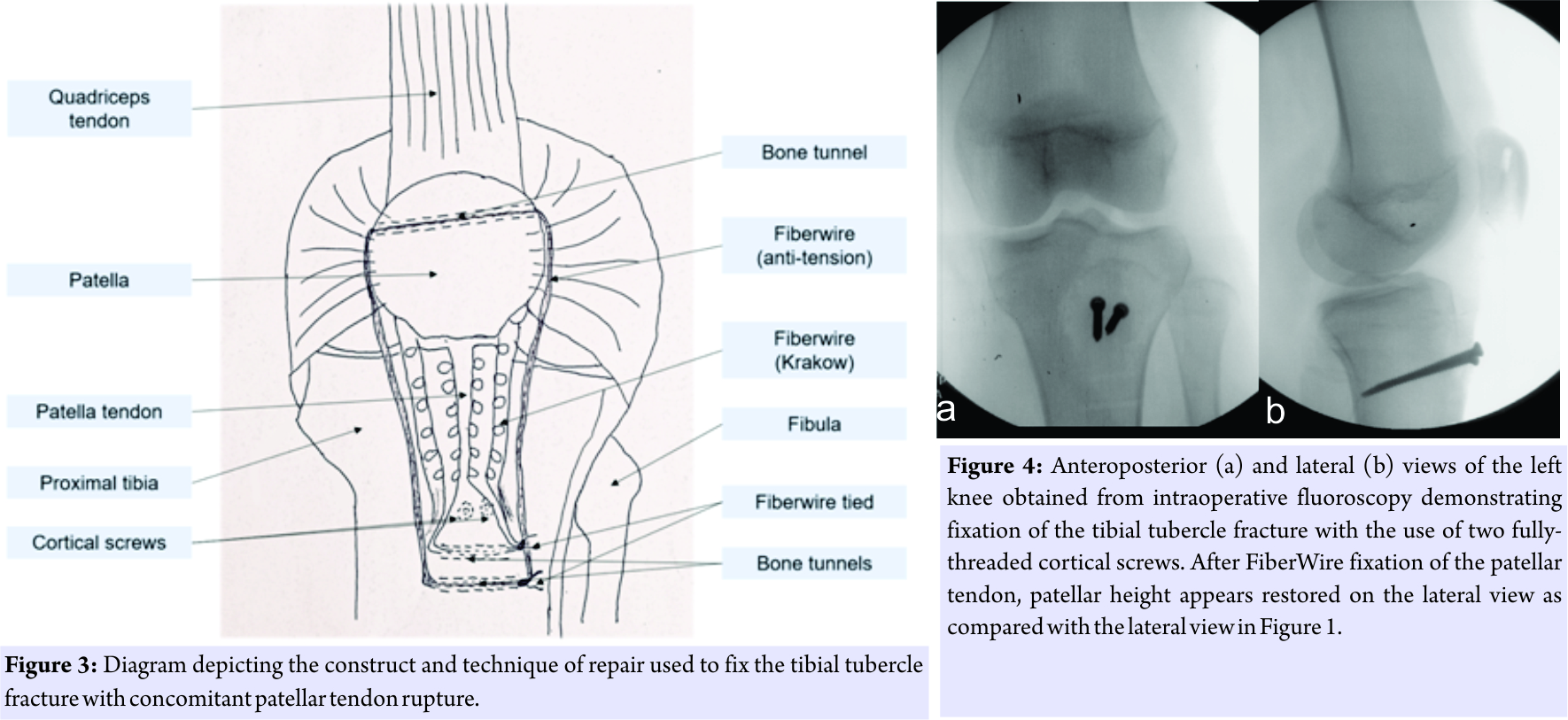[box type=”bio”] Learning Point for the Article: [/box]
Although rare, combined tibial tubercle fractures with patellar tendon avulsions are an important consideration and require surgical technique that addresses both injuries.
Case Report | Volume 8 | Issue 3 | JOCR May – June 2018 | Page 18-22| Omar A Behery, Oren I Feder, Bryan G Beutel, David H Godfried. DOI: 10.13107/jocr.2250-0685.1090
Authors: Omar A Behery[1], Oren I Feder[2], Bryan G Beutel[1], David H Godfried[1]
[1] Department of Orthopaedic Surgery, NYU Langone Medical Center, Hospital for Joint Diseases, New York, USA.
[2] Albert Einstein College of Medicine, Bronx, New York, USA.
Address of Correspondence:
Dr. Omar A Behery,
301 E 17th Street, Third Floor, New York, NY – 10003, USA.
E-mail: omar.behery@nyumc.org
Abstract
Introduction: Isolated tibial tubercle fractures or patellar tendon ruptures are common injuries in adolescents. However, combined tubercle fractures with patellar tendon ruptures are rare, and hence, there are no definitive methods of surgical fixation or post-operative protocols.
Case Report: A 13-year-old healthy girl sustained an extensor mechanism injury after the left knee hyperflexion during a fall from skateboarding. On examination, the extensor mechanism was not functional against gravity. Radiographic imaging revealed a displaced tibial tubercle fracture with patella alta, and magnetic resonance imaging revealed a concomitant patellar tendon avulsion from the tubercle. From a supine position on a radiolucent table, under general anesthesia and a femoral nerve block, the tibial tubercle fracture was fixed using two fully-threaded cortical screws. The patellar tendon was repaired with Fiber Wire through the Krakow method and secured through a tibial transosseous tunnel. A supplemental Fiber Wire was passed through a patellar tunnel and into a tibial tunnel to mitigate tension on the tendon repair. Post-operative knee motion was limited for 1weekto 60°of passive flexion, and full weight-bearing was permitted in a knee immobilizer.
Conclusion: Given the rarity of this combined extensor mechanism injury in adolescents and despite several different fixation methods reported in the literature, there is no clearly superior surgical technique. This case demonstrates a technique allowing for stability of the tubercle fracture and robust repair of the patellar tendon that permit searly range of motion and weight-bearing.
Keywords: Tibial tubercle fracture, patellar tendon avulsion, technique, surgery.
Introduction
Physically, active adolescents are at particular risk for extensor mechanism injuries including patellar tendon ruptures or tibial tubercle fractures. Tibial tubercle avulsion fractures are uncommon and represent <1% of all physeal injuries [1], while patellar tendon ruptures are also uncommon with no clearly reported incidence. The combination of a tibial tubercle fracture with a concomitant patellar tendon rupture is a particularly rare occurrence, with only a few reported cases in the literature [2, 3, 4, 5, 6, 7, 8, 9, 10, 11, 12, 13]. This unique combined injury to the extensor mechanism presents a challenge for operative fixation. Based on the aforementioned reported cases, a variety of surgical techniques to address the tibial tubercle fracture include open reduction and internal fixation with Kirschner wires, Sherman or cancellous screws, and cerclage wires, while the majority of techniques to address the patellar tendon rupture use suture repair of tendon to periosteum or transosseous sutures through the tibia. Moreover, there is variability with respect to recommended post-operative rehabilitation. The majority of post-operative protocols involve a short period of immobilization (4 weeks)with a cylinder or long leg cast and full weight-bearing, while few other authors have instituted early range of motion. There is no clearly favored approach toward operative fixation given the rarity of this type of injury. We present a case with this injury pattern and report on our surgical technique to facilitate early weight-bearing and knee range of motion. The authors have obtained the patient and parent’s informed written consent for print and electronic publication of the case report.
Case Report
The patient is a 13-year-old girl with no prior medical history who fell while skateboarding onto a hyper flexed left knee on the day of presentation. She experienced an immediate onset of knee pain with subsequent swelling and was unable to ambulate due to pain and weakness in her left leg. A review of systems was negative for sensory abnormalities or pain in other anatomical locations. On physical examination, the skin over the left knee was intact with no abrasions or open wounds. There was diffuse soft tissue swelling around the knee as well as a moderate knee joint effusion. She had exquisite tenderness to palpation directly over the tibial tubercle and patellar tendon, with an asymmetrically high-riding patella on palpation compared to the contralateral extremity. Although she was unable to straight leg raise against gravity, she was able to perform the maneuver with gravity eliminated, with moderate pain. Distally, she demonstrated full motor strength with ankle and great toe dorsi-and plantar flexion. Her sensation was grossly intact to light touch in all distributions distally. After examination, she underwent plain film imaging (Fig. 1), which demonstrated a displaced tibial tubercle fracture extending to the level of the proximal tibial physis (Ogden Type IIB) with concomitant patella alta. Given the latter finding, concern was raised for patellar tendon injury, and magnetic resonance imaging was obtained which demonstrated a patellar tendon rupture at the tubercle insertion site (Fig. 2).

Discussion
Isolated tibial tubercle fractures characteristically occur in adolescents aged 13–17 years through a mechanism involving eccentric contraction of the patellar tendon when the proximal tibial physis is closing [15]. However, in rare cases, failure of the extensor mechanism can be combined and involves rupture of the patellar tendon fromits tibial tubercle insertion with a concomitant tubercle fracture, as in the reported 15 cases [2, 3, 4, 5, 6, 7, 8, 9, 10, 11, 12, 13]. In the current presented case of an adolescent with this type of injury, the mechanism appears similar to those reported in other cases. Nonetheless, it remains unclear why the extensor mechanism fails at two distinct locations, as there is no apparent difference in the mechanism for this injury compared with the typical isolated tubercle fractures or patellar tendon ruptures. Given the bifocal nature of this unique injury pattern, an operative intervention should be performed with the goals of anatomic reduction and biomechanically stable fixation of the tubercle fracture, as well as a repair of the patellar tendon to the proximal tibia that is strong enough to withstand tensile forces from early range of motion and also correct the patella alta. In our described technique, K-wires were used effectively to maintain reduction of the tubercle, while fully-threaded cortical screws were utilized to allow for compression and absolute stability of the fragment. Furthermore, the patellar tendon was repaired through proximal tibia transosseous tunnels, given that the tubercle periosteum was avulsed from the bone. The addition of a Fiber Wire construct through the patella into a separately drilled proximal tibial tunnel as previously described [14] offered adequate reinforcement to our tendon repair while off-loading tension on the repair. When performing this step, however, care must be taken to avoid over tensioning this suture, which would introduce excessive slack into the tendon repair and potentially weaken the extensor mechanism. Post-operative recovery protocols in the existing case reports range from leg casting for 4 weeks to early range of motion. Most protocols allow full weight-bearing immediately. With our performed surgical technique, we believe the repair is biomechanically strong enough to withstand early range of motion, with restriction to 60°of flexion to protect the repair from excessive tensile stress. A post-operative knee immobilizer was used for the 1stweek while weight-bearing to protect against potential injury to the repair from simultaneous flexion while bearing full weight. Further, follow-up will be continued to determine improvement in the patient’s functional capacity.
Conclusion
A combined tibial tubercle fracture and patellar tendon rupture is a rare injury in adolescents. Multiple fixation techniques and restricted post-operative range of motion protocols have been reported. This case report demonstrates a technique for screw and Fiber Wire surgical fixation to address both injuries and allow early range of motion and weight-bearing.
Clinical Message
This uncommon injury pattern results in an inherently unstable, incompetent extensor mechanism which necessitates surgical intervention. Screw fixation of the tibial tubercle and suture fixation of the patellar tendon, coupled with a tension-reducing, off-loading circumferential Fiber Wire suture, yield a stable construct that permits early functional range of motion.
References
1. Hamilton SW, Gibson PH. Simultaneous bilateral avulsion fractures of the tibial tuberosity in adolescence: A case report and a review of over 50 years of literature. Knee 2006;13:404-7.
2. Clarke DO, Franklin SA, Wright DE. Avulsion fracture of the tibial tubercle associated with patellar tendon avulsion. Orthopedics 2016;39:e561-4.
3. Frankl U, Wasilewski SA, Healy WL. Avulsion fracture of the tibial tubercle with avulsion of the patellar ligament. Report of two cases. J Bone Joint Surg Am 1990;72:1411-3.
4. Frey S, Hosalkar H, Cameron DB, Heath A, David Horn B, Ganley TJ, et al. Tibial tuberosity fractures in adolescents. J Child Orthop 2008;2:469-74.
5. Goodier D, Maffulli N, Good CJ. Tibial tuberosity avulsion associated with patellar tendon avulsion. Acta Orthop Belg 1994;60:336-8.
6. Kaneko K, Miyazaki H, Yamaguchi T. Avulsion fracture of the tibial tubercle with avulsion of the patellar ligament in an adolescent female athlete. Clin J Sport Med 2000;10:144-5.
7. Kramer DE, Chang TL, Miller NH, Sponseller PD. Tibial tubercle fragmentation: A clue to simultaneous patellar ligament avulsion in pediatric tibial tubercle fractures. Orthopedics 2008;31:501.
8. Mayba II. Avulsion fracture of the tibial tubercle apophysis with avulsion of patellar ligament. J Pediatr Orthop 1982;2:303-5.
9. Mosier SM, Stanitski CL. Acute tibial tubercle avulsion fractures. J Pediatr Orthop 2004;24:181-4.
10. Sie EJ, Kacou AD, Sery BL, Lambin Y. Avulsion fracture of the tibial tubercle associated with patellar ligament avulsion treated by staples. Afr J Paediatr Surg 2011;8:105-8.
11. Sullivan L, Lee CB, Simonian PT. Simultaneous avulsion fracture of the tibial tubercle with avulsion of the patellar ligament. Am J Knee Surg 2000;13:156-8.
12. Swan K Jr., Rizio L. Combined avulsion fracture of the tibial tubercle and avulsion of the patellar ligament. Orthopedics 2007;30:571-2.
13. Uppal R, Lyne ED. Tibial tubercle fracture with avulsion of the patellar ligament: A case report. Am J Orthop (Belle Mead NJ) 2007;36:273-4.
14. Novacheck TF, Stout JL, Gage JR, Schwartz MH. Distal femoral extension osteotomy and patellar tendon advancement to treat persistent crouch gait in cerebral palsy. Surgical technique. J Bone Joint Surg Am 2009;91 Suppl 2:271-86.
15. Pandya NK, Edmonds EW, Roocroft JH, Mubarak SJ. Tibial tubercle fractures: Complications, classification, and the need for intra-articular assessment. J Pediatr Orthop 2012;32:749-59.
 |
 |
 |
 |
| Dr. Omar A Behery | Dr. Oren I Feder | Dr. Bryan G Beutel | Dr. David H Godfried |
| How to Cite This Article: Behery O A, Feder O I, Beutel B G, Godfried D H. Combined Tibial Tubercle Fracture and Patellar Tendon Avulsion: Surgical Technique and Case Report. Journal of Orthopaedic Case Reports 2018. May- June; 8(3): 18-22. |
[Full Text HTML] [Full Text PDF] [XML]
[rate_this_page]
Dear Reader, We are very excited about New Features in JOCR. Please do let us know what you think by Clicking on the Sliding “Feedback Form” button on the <<< left of the page or sending a mail to us at editor.jocr@gmail.com





